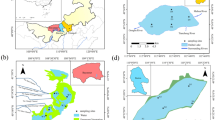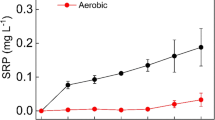Abstract
Purpose
Increased temperatures can promote phosphorus (P) mobilization in black-odor sediments. It is generally believed that the temperature-induced release of P from sediments is mainly controlled by iron reduction, while the role of sulfate reduction is often neglected. In this study, the effect and mechanism of sulfate reduction on P release in response to increasing temperatures were investigated.
Materials and methods
In January 2021, a total of nine sediment cores were collected in the Zhongzi River, a typical black-odorous river, using a gravity sampler. When all samples had been transported to the laboratory, three sediment cores were placed in three different tanks for incubation, and the water temperature in the tanks was controlled at 5 ℃, 15 ℃, or 25 ℃ through circulating water flumes. Following a 15-day incubation, the diffusive gradients in thin films (DGT) were combined, and the high-resolution dialysis (HR-Peeper), P sequential extraction, and the 16S rRNA amplicon sequencing techniques were used to investigate the relationship between temperature changes and variations in sulfate reduction rates and P migration.
Results and discussion
A rise in the temperature from 5 to 25 ℃, the concentrations of labile sulfide (S(-II)) and soluble reactive P (SRP) in porewater, and the vertical distribution trends of these two variables were significantly and positively correlated (r ≥ 0.45, p ≤ 0.05). Meanwhile, the largest decrease in organic P (OP) and iron-bound phosphorus (Fe–P) was observed in sediments. Further analysis found that the relative abundance of sulfate-reducing bacteria (SRB) increased from 4.35 to 5.43%, while that of iron-reducing bacteria (IRB) decreased from 4.99 to 3.68%, indicating that SRB inhibited the growth of IRB and that microbial sulfate reduction (MSR) became the primary pathway of OP mineralization. Although the growth of IRB was inhibited, the Fe–P and Fe(III) oxide content in sediments were significantly reduced, indicating that chemical iron reduction (CIR) had occurred.
Conclusions
Increasing temperatures promoted the propagation of SRB and inhibited the growth of IRB in black-odor sediments, which not only made MSR become the primary pathway of OP mineralization but also changed the main pathway of iron reduction so that microbial iron reduction (MIR) was replaced by S(-II)-induced CIR, leading to high mobilization of P in black-odor sediments.






Similar content being viewed by others
Data availability
The datasets generated during and/or analyzed during the current study are available from the corresponding authors on reasonable request.
References
Aharon P, Fu B (2000) Microbial sulfate reduction rates and sulfur and oxygen isotope fractionations at oil and gas seeps in deepwater Gulf of Mexico. Geochim Cosmochim Acta 64(2):233–246. https://doi.org/10.1016/S0016-7037(99)00292-6
Branch GM, Bustamante RH, Robinson TB (2013) Impacts of a ‘black tide’ harmful algal bloom on rocky-shore intertidal communities on the West Coast of South Africa. Harmful Algae 24:54–64. https://doi.org/10.1016/j.hal.2013.01.005
Cao J, Sun Q, Zhao D, Xu M, Shen Q, Wang D, Wang Y, Ding S (2020) A critical review of the appearance of black-odorous waterbodies in China and treatment methods. J Hazard Mater 385:121511. https://doi.org/10.1016/j.jhazmat.2019.12
Chen G, Luo J, Zhang C, Jiang L, Tian L, Chen G (2018) Characteristics and influencing factors of spatial differentiation of urban black and odorous waters in China. Sustainability 10:4747. https://doi.org/10.3390/su10124747
Chen YQ, Shen LL, Huang T, Chu ZD, Xie ZQ (2019) Transformation of sulfur species in lake sediments at Ardley Island and Fildes Peninsula, King George Island, Antarctic Peninsula. Sci Total Environ 703:135591. https://doi.org/10.1016/j.scitotenv.2019.135591
Cheng X, Huang Y, Li R, Pu X, Huang W, Yuan X (2020) Impacts of water temperature on phosphorus release of sediments under flowing overlying water. J Contam Hydrol 235:103717. https://doi.org/10.1016/j.jconhyd.2020.103717
Couture R-M, Gobeil C, Tessier A (2010) Arsenic, iron and sulfur co-diagenesis in lake sediments. Geochim Cosmochim Acta 74(4):1238–1255. https://doi.org/10.1016/j.gca.2009.11.028
Ding S, Sun Q, Xu D, Jia F, He X, Zhang C (2012) High-resolution simultaneous measurements of dissolved reactive phosphorus and dissolved sulfide: the first observation of their Simultaneous release in sediments. Environ Sci Technol 46(15):8297–8304. https://doi.org/10.1021/es301134h
Ding S, Wang Y, Wang D, Li YY, Gong M, Zhang C (2016) In situ, high-resolution evidence for iron-coupled mobilization of phosphorus in sediments. Sci Rep 6(1):24341. https://doi.org/10.1038/srep24341
Han C, Ding S, Yao L, Shen Q, Zhu C, Wang Y, Xu D (2015) Dynamics of phosphorus–iron–sulfur at the sediment–water interface influenced by algae blooms decomposition. J Hazard Mater 300:329–337. https://doi.org/10.1016/j.jhazmat.2015.07.009
Han T, Kong M, Tang C, Xu X, Zhu Y, Gao Y, Zhang T, Zhang Y, Li W (2021) Influence of algal blooms on the efficacy of La/Al-based phoslock in the control of phosphorus release from sediment in shallow lakes: a microcosm study. J Soils Sediments 21:3405–3414. https://doi.org/10.1007/S11368-021-02972-5
Kong M, Han T, Chen M, Zhao D, Chao J, Zhang Y (2021a) High mobilization of phosphorus in black-odor river sediments with the increase of temperature. Sci Total Environ 775:145595. https://doi.org/10.1016/j.scitotenv.2021.145595
Kong M, Zhu YZ, Han TL, Zhang S, Li JL, Xu XT, Chao JY, Zhang YM, Gao YX (2021b) Interactions of heavy metal elements across sediment-water interface in Lake Jiaogang. Environ Pollut 286(4):117578. https://doi.org/10.1016/j.envpol.2021.117578
Kristiansen KD, Kristensen E, Jensen EMH (2002) The influence of water column hypoxia on the behaviour of manganese and iron in sandy coastal marine sediment. Estuar Coast Shelf Sci 55(4):645–654. https://doi.org/10.1006/ecss.2001.0934
Ku TCW, Kay J, Browne E, Martini AM, Peters SC, Chen MD (2008) Pyritization of iron in tropical coastal sediments: implications for the development of iron, sulfur, and carbon diagenetic properties, Saint Lucia. Lesser Antilles Mar Geol 249(3):184–205. https://doi.org/10.1016/j.margeo.2007.12.001
Li B, Feng M, Chen X, Wang Y, Shen Y, Wu QL (2020a) Abundant sediment organic matter potentially facilitates chemical iron reduction and surface water blackness in a Chinese deep lake. Environ Pollut 272. https://doi.org/10.1016/j.envpol.2020.116002
Li R, Gao L, Wu QR, Liang ZB, Hou L, Yang ZG, Chen JY, Jiang T, Zhu AP, Li MZ (2021) Release characteristics and mechanisms of sediment phosphorus in contaminated and uncontaminated rivers: a case study in South China. Environ Pollut 268. https://doi.org/10.1016/j.envpol.2020.115749
Li Y, Wang LG, Chao CX, Yu HW, Yu D, Liu CH (2020b) Submerged macrophytes successfully restored a subtropical aquacultural lake by controlling its internal phosphorus loading. Environ Pollut. https://doi.org/10.1016/j.envpol.2020.115949
Liang ZW, Siegert M, Fang WW, Sun Y, Jiang F, Lu H, Chen GH, Wang SQ (2017) Blackening and odorization of urban rivers: a bio-geochemical process. FEMS Microbiol Ecol 94(3). https://doi.org/10.1093/femsec/fix180
Liu Q, Ding SM, Chen X, Sun Q, Chen MS, Zhang CS (2018) Effects of temperature on phosphorus mobilization in sediments in microcosm experiment and in the field. Appl Geochem 88:158–166. https://doi.org/10.1016/j.apgeochem.2017.07.018
Lovley DR, Woodward JC (1996) Mechanisms for chelator stimulation of microbial Fe(III)-oxide reduction. Chem Geol 132(1–4):19–24. https://doi.org/10.1016/S0009-2541(96)00037-X
Norgbey E, Li YP, Ya Z, Li RH, Nwankwegu AS, Takyi-Annan GE, Luo F, Jin W, Huang YN, Sarpong LD (2020) High resolution evidence of iron-phosphorus-sulfur mobility at hypoxic sediment water interface: an insight to phosphorus remobilization using DGT-induced fluxes in sediments model. Sci Total Environ 724:138204. https://doi.org/10.1016/j.scitotenv.2020.138204
Pan F, Liu HT, Cuo ZR, Li ZW, Wang B, Cai Y, Gao AG (2019) Effects of tide and season changes on the iron-sulfur-phosphorus biogeochemistry in sediment porewater of a mangrove coast. J Hydrol 568:686–702. https://doi.org/10.1016/j.jhydrol.2018.11.002
Rong N, Lu W, Zhang C, Wang Y, Zhu J, Zhang W, Lei P (2020) In situ high-resolution measurement of phosphorus, iron and sulfur by diffusive gradients in thin films in sediments of black-odorous rivers in the Pearl River Delta region, South China. Environ Res 189:109918. https://doi.org/10.1016/j.envres.2020.109918
Rozan TF, Taillefert M, Trouwborst RE, Glazer BT, Ma S, Herszage J, Valdes LM, Price KS, Lutger GW (2002) Iron-sulfurphosphorus cycling in the sediments of a shallow coastal bay: implications for sediment nutrient release and benthic macroalgal blooms. Limnol Oceanogr 47(5):1346–1354. https://doi.org/10.4319/lo.2002.47.5.1346
Rydin E, Welch EB (1998) Aluminum dose required to inactivate phosphate in lake sediments. Water Res 32:2969–2976. https://doi.org/10.1016/S0043-1354(98)00055-4
Shi LM, Huang YX, Zhang M, Yu Y, Lu YP, Kong FX (2017) Bacterial community dynamics and functional variation during the long-term decomposition of cyanobacterial blooms in-vitro. Sci Total Environ 598:77–86. https://doi.org/10.1016/j.scitotenv.2017.04.115
Sun Q, Sheng Y, Yang J, Di Bonito M, Mortimer RJG (2016) Dynamic characteristics of sulfur, iron and phosphorus in coastal polluted sediments, North China. Environ Pollut 219:588–595. https://doi.org/10.1016/j.envpol.2016.06.019
Tammeorg O, Nürnberg GK, Nõges P, Niemistö J (2022) The role of humic substances in sediment phosphorus release in northern lakes. Sci Total Environ 833:155257. https://doi.org/10.1016/J.SCITOTENV.2022.155257
Tamura H, Goto K, Yotsuyanagi T, Nagayama M (1974) Spectrophotometric determination of iron(II) with 1,10-phenanthroline in the presence of large amounts of iron(III). Talanta 21(4):314–318. https://doi.org/10.1016/0039-9140(74)80012-3
Wang CH, Wei Z, Shen XY, Bai LL, Jiang HL (2022a) Particle size-related vertical redistribution of phosphorus (P)-inactivating materials induced by resuspension shaped P immobilization in lake sediment profile. Water Res 213:118150. https://doi.org/10.1016/J.WATRES.2022.118150
Wang Z, Chen Y, Chen L, Xi S, Liu Y, Dong Y, Miao L (2020) Ex-situ treatment of sediment from a black-odor water body using activated sludge. Sci Total Environ 713:136651. https://doi.org/10.1016/j.scitotenv.2020.136651
Wang ZC, Huang S, Li DH (2019) Decomposition of cyanobacterial bloom contributes to the formation and distribution of iron-bound phosphorus (Fe-P): insight for cycling mechanism of internal phosphorus loading. Sci Total Environ 652:696–708. https://doi.org/10.1016/j.scitotenv.2018.10.260
Wang ZL, Wang CH, Jiang HL, Liu H (2022b) Higher dissolved oxygen levels promote downward migration of phosphorus in the sediment profile: implications for lake restoration. Chemosphere 301:134705. https://doi.org/10.1016/j.chemosphere.2022.134705
Wu SJ, Zhao YP, Chen YY, Dong XM, Wang MY, Wang GX (2018) Sulfur cycling in freshwater sediments: a cryptic driving force of iron deposition and phosphorus mobilization. Sci Total Environ 657:1294–1303. https://doi.org/10.1016/j.scitotenv.2018.12.161
Yao Y, Li DJ, Chen Y, Han XX, Wang GX, Han RM (2022) High-resolution characteristics and mechanisms of endogenous phosphorus migration and transformation impacted by algal blooms decomposition. Sci Total Environ 820:152907. https://doi.org/10.1016/j.scitotenv.2021.152907
Yin H, Yang P, Kong M, Li W (2020) Use of lanthanum/aluminum co-modified granulated attapulgite clay as a novel phosphorus (P) sorbent to immobilize P and stabilize surface sediment in shallow eutrophic lakes. Chem Eng J 385:123395. https://doi.org/10.1016/j.cej.2019.123395
Zhang SY, Zhao YP, Zhou CQ, Duan HX, Wang GX (2020) Dynamic sulfur–iron cycle promoted phosphorus mobilization in sediments driven by the algae decomposition. Ecotoxicology 1–10. https://doi.org/10.1007/s10646-020-02316-y
Zhao YP, Wu SJ, Yu MT, Zhang ZQ, Wang X, Zhang SY, Wang GX (2020) Seasonal iron-sulfur interactions and the stimulated phosphorus mobilization in freshwater lake sediments. Sci Total Environ 768:144336. https://doi.org/10.1016/j.scitotenv.2020.144336
Acknowledgements
This work was financially supported by the Special Fund of Chinese Central Government for Basic Scientific Research Operations in commonweal Research Institute (GYZX230306), Jiangsu Funding Program for Excellent Postdoctoral Talent (2022, China), and the Xinjiang Science and Technology Support Project Plan (2022E02026).
Funding
This work was financially supported by the Special Fund of the Chinese Central Government for Basic Scientific Research Operations in Commonweal Research Institute (GYZX230306), the Jiangsu Funding Program for Excellent Postdoctoral Talent (2022, China), and the Xinjiang Science and Technology Support Project Plan (2022E02026).
Author information
Authors and Affiliations
Corresponding authors
Ethics declarations
Conflict of interest
The authors declare no competing interests.
Additional information
Responsible editor: Hezhong Yuan
Publisher's Note
Springer Nature remains neutral with regard to jurisdictional claims in published maps and institutional affiliations.
Supplementary Information
Below is the link to the electronic supplementary material.
Rights and permissions
Springer Nature or its licensor (e.g. a society or other partner) holds exclusive rights to this article under a publishing agreement with the author(s) or other rightsholder(s); author self-archiving of the accepted manuscript version of this article is solely governed by the terms of such publishing agreement and applicable law.
About this article
Cite this article
Han, T., Zhou, K., Chao, J. et al. Sulfate reduction promotes the release of organic phosphorus and iron-bound phosphorus in black-odor sediments in response to increased temperatures. J Soils Sediments 23, 3191–3200 (2023). https://doi.org/10.1007/s11368-023-03562-3
Received:
Accepted:
Published:
Issue Date:
DOI: https://doi.org/10.1007/s11368-023-03562-3




